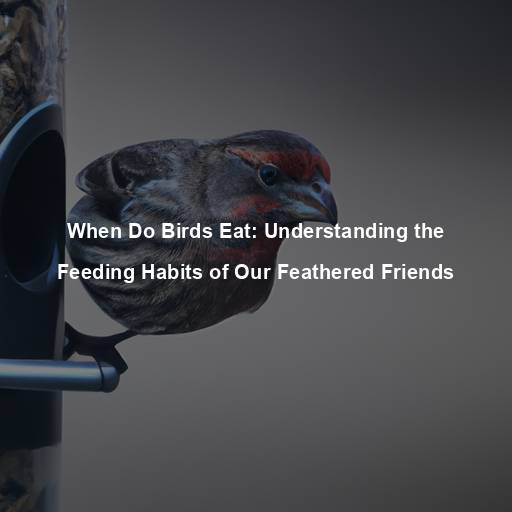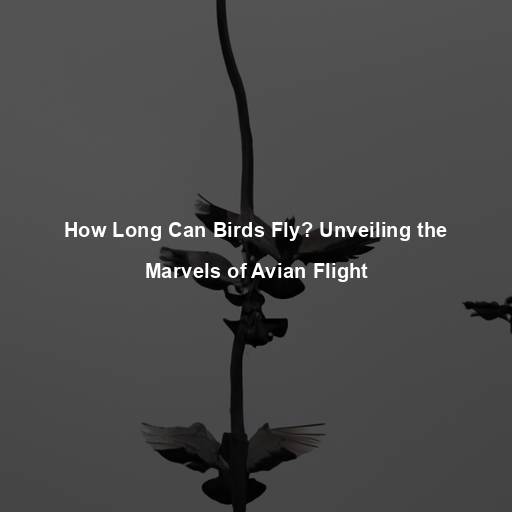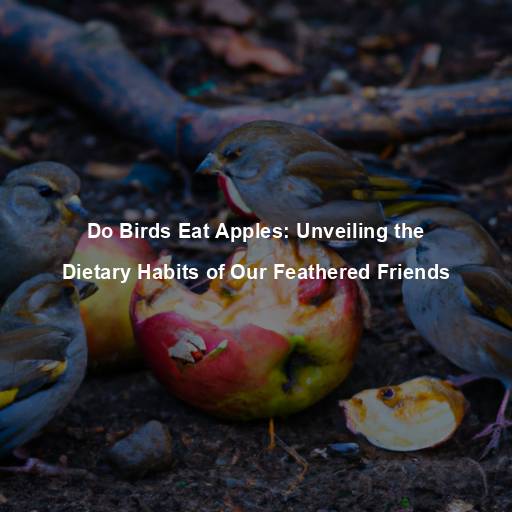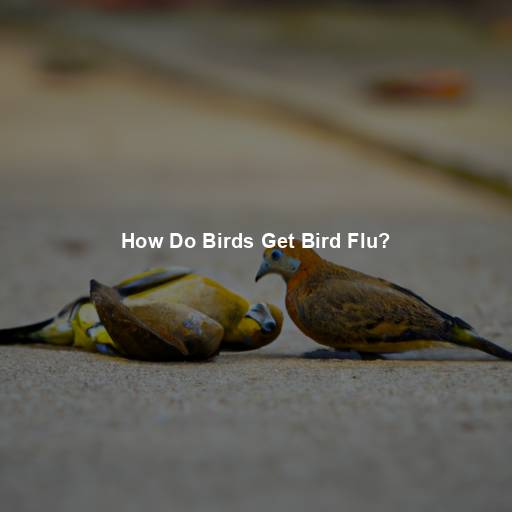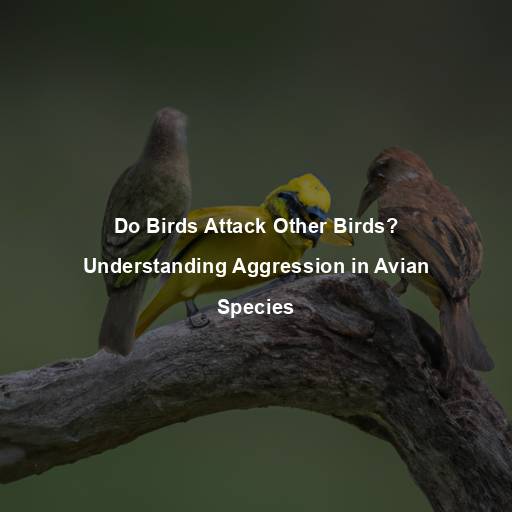When Do Birds Eat: Understanding the Feeding Habits of Our Feathered Friends
Last Updated on August 3, 2023 by Evan
Contents [hide]
- 1
- 2 The Circadian Rhythm of Birds
- 3 Factors Influencing Bird Feeding Habits
- 4 Common Misconceptions about Bird Feeding
- 5 Feeding Strategies of Different Bird Species
- 6 The Significance of Bird Feeding Studies
- 7 The Role of Bird Beaks in Feeding Adaptations
- 8 Human Impact on Bird Feeding Habits
- 9 The Intricacies of Bird Digestion
- 10 FAQs about when birds eat
Step into the enchanting world of avian beings, where feathers dance in a kaleidoscope of colors, melodies weave through the air, and creatures take to the skies with effortless grace. Have you ever pondered the enigmatic question of when birds satisfy their hunger? Prepare to be astounded as we embark on a mesmerizing exploration of their feeding patterns, unraveling the intricacies that govern their meal times and untangling the web of misconceptions that surround their dietary habits. Get ready to don your trusty binoculars and partake in a captivating journey through the realm of birds, as we unveil the secrets behind their daily feasts!
The Circadian Rhythm of Birds
The Internal Clock: A Key Player
Just like humans, birds have an internal clock known as the circadian rhythm that regulates their daily activities, including feeding. This biological clock is influenced by various external factors such as light, temperature, and food availability. By understanding the circadian rhythm, we can gain valuable insights into when birds are most likely to eat.
Early Birds: The Morning Feeders
Many bird species are early risers and tend to feed shortly after dawn. This is because the morning hours provide optimal conditions for foraging. The cooler temperatures, reduced wind, and lower predation risk make it easier for birds to find food and replenish their energy reserves after a night of fasting.
Afternoon Delight: Midday Feeding
As the day progresses and temperatures rise, some birds take a break from foraging and seek shelter to avoid the heat. However, certain species, such as raptors and seabirds, are known to be active during the middle of the day. They take advantage of thermal currents and coastal upwellings to locate their prey and indulge in a midday feast.
Twilight Treats: Evening Dining
As day slowly transforms into night, a bewildering spectacle unfolds in the avian realm. Like clockwork, a perplexing phenomenon called crepuscular activity emerges, captivating the hearts of creatures that thrive on a diet of insects. This twilight spectacle offers a bountiful feast for our feathered friends, as the insects silly enough to be active at this hour unwittingly offer themselves as tantalizing targets. This is their chance to refuel, replenishing their energy stores before the curtain falls on another day.
Factors Influencing Bird Feeding Habits
Food Availability: The Ultimate Decider
One of the most significant factors influencing when birds eat is the availability of food. Birds are opportunistic feeders, meaning they rely on the presence of food sources to determine their feeding times. Different bird species have varying dietary preferences, and their feeding habits are closely tied to the availability of their preferred food sources.
Seasonal Changes: Nature’s Menu
Seasonal changes play a crucial role in bird feeding habits. During the breeding season, when birds require additional energy for reproduction, their feeding behaviors may shift. For instance, certain species may become more active during the early morning and late afternoon to maximize their foraging opportunities. Similarly, during the winter months, when food resources are scarce, birds may alter their feeding patterns to ensure their survival.
Migration: Fueling the Journey
Migration is a remarkable phenomenon observed in many bird species. Before embarking on their long-distance journeys, migratory birds undergo a period of intense feeding known as pre-migration hyperphagia. During this time, birds consume vast amounts of food to build up fat reserves, which serve as their fuel source during migration. Understanding the timing of migration and the associated feeding habits is crucial for conservation efforts and ensuring the well-being of these incredible travelers.
Common Misconceptions about Bird Feeding
Myth: Birds Only Eat in the Morning
Contrary to popular belief, birds do not exclusively feed in the morning. While it is true that many bird species are more active during the early hours, their feeding habits can vary depending on factors such as food availability, environmental conditions, and individual preferences. Understanding the specific feeding patterns of different bird species is essential to dispel this misconception.
Myth: Birds Eat Continuously
In the fascinating realm of avian dining, one discovers a plethora of feeding strategies, each more bewitching than the last. Take, for instance, the dainty hummingbird, whose metabolic tempo rivals that of a hummingbird’s wings, necessitating a ceaseless quest for sustenance. In stark contrast, regal predators like raptors, with their carnivorous cravings for more sizable morsels, adopt a more measured approach, savoring longer intervals between repasts. Such splendid disparities in the feeding patterns of our feathered friends remind us of the boundless diversity that exists within the avian realm.
Myth: Birds Only Eat Seeds and Insects
When it comes to food, birds are true culinary chameleons. It’s not just about seeds and insects – these feathered creatures have an incredible knack for diversifying their diets. From the fierce carnivores, who prefer a meaty delicacy of small mammals, reptiles, or even their fellow birds, to the elegant nectarivores who have a sweet tooth for floral nectar, birds have it all covered. And let’s not forget the specialized eaters, those frugivores that can’t resist a juicy fruit or those piscivores who have a craving for a fresh fishy feast.
A Human Intervention
Intriguingly, it seems that bird feeders have become quite the craze among individuals who find avian companionship a captivating endeavor. These ingenious contraptions, acting as faux nourishing stations, hold the power to shape the eating patterns of said birds. As a result, one cannot help but question whether these artificial dining options may just tweak the feathered creatures’ innate foraging instincts, causing a perplexing shift in their usual behaviors. Truly, the mysteries of avian interaction with these modern inventions continue to fascinate and bemuse bird enthusiasts worldwide.
The Feeder Effect: A Shift in Feeding Patterns
When bird feeders are introduced into an environment, birds may adjust their feeding schedules to take advantage of the readily available food. Some species may become more active during the times when feeders are typically filled, anticipating the arrival of a meal. This can lead to a disruption in their natural feeding patterns and a reliance on human-provided food sources.
Potential Consequences
Bird feeders can certainly provide advantages like boosting bird populations and allowing for better bird-watching opportunities. Nevertheless, it’s crucial to acknowledge that there are certain downsides to consider as well. Birds that heavily depend on feeders may struggle to search for natural food, potentially affecting their ability to survive in the wild. Moreover, the gathering of birds around feeders might heighten the risk of disease transmission and competition among them.
Feeding Strategies of Different Bird Species
Insectivores: Hunting for Protein
Birds have a real knack for catching insects – it’s like they have their own secret spy network. These “insectivores” are like the superheroes of the bird world, swooping in to save the day by keeping those pesky insect populations in check. They’ve got quite the menu too, with insects being the main course for these feathered foodies. Whether they’re doing acrobatics in the air or using some other fancy hunting techniques, these birds know how to make their meals burst with flavor.
Granivores: Seeds as Staples
Birds that have a love affair with seeds, famously known as granivorous birds, possess beaks uniquely sculpted to tackle those tough shells. Their diets primarily consist of a smorgasbord of grains and seeds, acting as a vital source of fuel and nutrients. These feathery fellows can often be found bustling on the ground, seizing fallen seeds or combing through grassy realms in a quest for culinary delights. However, their dining rituals may alter course depending on the whims of seed availability within their natural habitats, keeping their appetite in constant motion.
Frugivores: Enjoying Fruity Delights
Frugivorous birds have a particular affinity for fruits, which make up a significant portion of their diet. They play a crucial role in seed dispersal, helping to regenerate forests and support plant diversity. These birds may have specialized beaks and digestive systems that enable them to consume and process a wide variety of fruits. Their feeding habits are often influenced by fruiting seasons, as they seek out ripe and nutritious offerings.
Carnivores: The Hunters of the Sky
In the wild world of avian hunters, the likes of raptors and owls reign supreme, displaying their impressive ravenousness for small mammals, reptiles, and fellow birds. With razor-sharp beaks and fearsome talons, these majestic creatures possess the tools of a perfect predator, skillfully seizing and dispatching their unsuspecting prey. Their feeding rituals are a mosaic of stillness and keen observation, punctuated by breathtaking bursts of aerial acrobatics, as they masterfully transform their surroundings into a hunting ground like no other.
The Significance of Bird Feeding Studies
Advancing Scientific Knowledge
Bird feeding habits offer a mesmerizing glimpse into the intricate world of avian biology and ecology. By delving into these feathered creatures’ dining preferences, we unlock a multitude of captivating secrets. Fascinating investigations unfold, shedding light on the consequences of shifting environments on bird populations, unveiling the mysterious routes of migration, and unraveling the subtle interplay between birds and their culinary delights. Moreover, this nuanced understanding of bird feeding behaviors grants us invaluable insights into the inner workings of food webs and the interwoven tapestry of ecosystem functioning.
Conservation Implications
By studying when and what birds eat, scientists can assess the health and availability of their food sources. This information is crucial for effective conservation efforts, especially in the face of habitat loss, climate change, and other threats to bird populations. Conservationists can use feeding studies to identify areas of concern, implement targeted conservation measures, and advocate for habitat protection.
Educating the Public
Feeding our avian friends is not just a hobby; it’s a chance to unlock the secrets of nature and truly connect with the world around us. As we delve into the fascinating realm of bird feeding studies, we discover a treasure trove of knowledge that not only ignites our curiosity but also empowers us to be stewards of the avian kingdom. By engaging in citizen science initiatives and sharing our findings, we have the potential to awaken a collective appreciation for birds, raising awareness about their importance and inspiring action to protect their habitats. Moreover, understanding the unique dietary needs of various bird species helps us create a haven in our own backyards, where we can nurture and sustain these magnificent creatures.
Seasonal Variations in Food Availability
Climate plays a significant role in shaping bird feeding habits, as it directly affects the availability of food sources. In temperate regions, birds experience distinct seasons, each with its own set of challenges and opportunities for finding food. During the spring and summer months, when food is abundant, birds may focus on raising their young and forage for insects or gather seeds for their growing families. In contrast, the colder winter months often bring scarcity, prompting birds to adapt their feeding strategies to survive until more favorable conditions return.
Migration and Feeding Patterns
Migration is a remarkable behavior displayed by many bird species, allowing them to travel long distances in search of suitable breeding grounds and food sources. The timing of migration is closely linked to food availability, as birds need to ensure a reliable supply of resources during their journey. Before embarking on their migratory flights, birds often undergo a period of intense feeding to accumulate fat stores that will sustain them throughout their travels. By understanding the relationship between migration and feeding habits, researchers can better predict and protect critical stopover sites along migratory routes.
Climate Change and Altered Feeding Patterns
The impacts of climate change are becoming increasingly evident, with rising temperatures, changes in precipitation patterns, and shifts in habitat distributions. These changes have the potential to significantly impact bird feeding habits. As temperatures rise, some bird species may alter their foraging behaviors to avoid the heat, shifting their feeding times to early morning or late evening when temperatures are cooler. Additionally, changes in the availability and timing of food resources due to climate change can disrupt the delicate balance between birds and their preferred prey, leading to potential mismatches in feeding opportunities.
The Role of Bird Beaks in Feeding Adaptations
The Beak as a Tool
In the wondrous world of birds, an extraordinary spectacle unfolds – the evolution of beaks, or as they are scientifically known, bills. These magnificent appendages have undergone a myriad of transformations, finely tuned to fit the unique needs of various feathered species in their respective ecological domains. Imagine the wonders, as the birds wield their beaks like versatile tools, adapting to a vast array of diets in a perplexing display of nature’s ingenuity. From the delicate, needle-like beaks of insect aficionados to the robust, cone-shaped beaks of seed enthusiasts, these beak designs embody the key to survival, allowing our avian friends to indulge in their favorite culinary delights.
Beak Diversity and Feeding Niches
Dive into the incredible world of avian wonders, where beak diversity reigns supreme. Witness the spectacular array of beak morphologies, ingeniously crafted for specific feeding preferences. Prepare to be astounded by the elegant curves and lengths of hummingbirds’ beaks, meticulously honed for extracting nectar from the depths of vibrant blooms. Brace yourself for the razor-sharp, hooked beaks of raptors, expertly designed to effortlessly slice into the succulent flesh of their unsuspecting prey.
Beaks and Foraging Techniques
Bird beaks also influence foraging techniques, dictating how a bird captures and consumes its food. Some birds, like woodpeckers, use their strong beaks to drill into tree bark and extract insects or sap. Others, like shorebirds, have long, slender beaks that probe into mud or sand to capture small invertebrates. The diversity of beak shapes and their corresponding foraging techniques highlight the incredible adaptability of birds and their ability to exploit different food resources.
Human Impact on Bird Feeding Habits
Habitat Destruction and Food Availability
Human activities, such as deforestation and urbanization, have a profound impact on bird feeding habits by altering their habitats and reducing food availability. Destruction of natural habitats can lead to the loss of critical food sources, forcing birds to adapt their feeding behaviors or seek alternative habitats. The conversion of forests into agricultural land, for example, may result in a decline in insect populations, affecting the feeding habits of insectivorous birds.
Artificial Food Sources and Dependency
As our urban landscapes continue to evolve, the practice of providing bird feeders and feeding stations has gained popularity. However, this seemingly benevolent act can have unforeseen consequences on our avian friends. The availability of human-provided food sources may inadvertently create a reliance on these artificial offerings, throwing a wrench in the delicate web of natural food chains. Furthermore, the mismanagement of bird feeders can turn these well-intentioned stations into breeding grounds for diseases, posing a threat to the well-being and foraging habits of our feathered companions.
Light Pollution and Nocturnal Feeding
With the rise of artificial lighting at night, we unknowingly become accomplices in the great mystery of disturbing the delicate dining preferences of our feathered friends. Nocturnal birds, those enchanting creatures of darkness, depend on the cover of night to satisfy their ravenous appetites for insects and little mammals. But alas! The blinding glare of artificial light can bewilder these avian hunters, throwing their hunting skills into disarray and causing them to rethink their entire dining strategy.
The Intricacies of Bird Digestion
Avian Digestive System
Birds have an incredible digestive system that leaves us humans feeling a bit envious. Say goodbye to teeth, because these feathered creatures rely solely on their trusty beaks to chomp down their meals. And don’t be fooled by their seemingly simple digestive process – it’s a fascinating series of events. Food first makes its way into the crop, a little storage pouch where it can hang out for a while.
Crop Milk: A Special Feeding Adaptation
When it comes to birds and their fascinating feeding habits, there is one specific adaptation that truly stands out: the enigmatic phenomenon of crop milk. Found in certain avian species including pigeons and doves, this peculiar secretion defies our expectations. Bursting with proteins, fats, and antibodies, crop milk is not your average baby food. In a bewildering display of parental devotion, adult birds regurgitate this nutritious elixir to nourish their precious nestlings.
Specialized Digestive Adaptations
Have you ever wondered how birds are able to survive and thrive in their diverse habitats? Well, it all comes down to their incredible ability to adapt and evolve. Take, for instance, the nectar-feeding birds like hummingbirds, with their seemingly magical tongues and amazing metabolic rates. These avian marvels have devised a way to extract every drop of energy from the delicate floral nectar.
FAQs about when birds eat
When do birds eat?
Birds typically eat during the day, especially in the early morning and late afternoon. They are diurnal creatures, meaning they are most active during daylight hours. Birds have developed a feeding pattern that aligns with the availability of light and food sources. However, it’s important to note that specific feeding times can vary depending on the species and their habitat.
Is there a specific time of day when birds eat the most?
While most birds have peak feeding times in the morning and late afternoon, the amount they eat can depend on various factors. These factors include the bird’s size, metabolism, and nutritional requirements. Generally, birds tend to eat more during their active hours to fuel their energy needs for flying, foraging, and other activities. Additionally, some birds may exhibit a feeding surge before migration or during breeding seasons when they require increased energy.
Do birds eat during the night?
Contrary to popular belief, the majority of our feathered friends prefer to take a break from their culinary adventures when the sun bids its adieu. Birds, being diurnal creatures, have a knack for making the most of daylight hours, flitting about and indulging in their favorite pastime of foraging for delightful culinary treats. However, nature always has a few mischievous surprises up her sleeve, as evidenced by certain avian rebels like the stealthy owls who prefer to savor their feasts under the enchantment of moonlight. Nevertheless, for the vast array of avifauna, nighttime signifies a time to rest their wings, perhaps basking in the allure of a cozy roost and replenishing their energy to embark on another vibrant day of hopping and fluttering.
Are there certain seasons when birds eat more?
It’s fascinating how birds have their own unique dining habits, isn’t it? When the air is fragrant with the promise of spring and the sun shines passionately over the world, these delightful creatures seemingly develop an insatiable appetite. As they prepare for the arrival of new life, their menu expands to include a bountiful buffet of insects, seeds, and other culinary delights. And let’s not forget about the wanderers amongst them, those enigmatic migratory birds who do not take their long journeys lightly. Before embarking on their epic migrations, they too engage in voracious feeding, stockpiling energy reserves like a seasoned marathon runner preparing for a race.
How often do birds need to eat?
Feeding our feathered friends can be a truly captivating endeavor, where each species unveils their own extraordinary dining routine. From the flamboyantly fastidious to the sublimely unhurried, every bird holds a unique appetite tempo. Those dainty, little creatures with their frenetic metabolic engines demand a constant flow of nourishment, maintaining their vibrant energy levels with frequent pit stops. While their larger counterparts, with their delicately sluggish metabolisms, adopt a more relaxed approach, choosing to savor their meals at a slower pace. Yet, amidst this cacophony of avian appetites, one should not overlook the role of ambient conditions, seasonal food availability, or the fluctuating chapters of a bird’s life, such as nesting or molt, all of which expertly choreograph the perplexing rhythm of their dining routine.
Do birds eat during winter?
Winter may seem like a barren time for birds, but contrary to popular belief, these resilient creatures don’t just hibernate their appetites away. The cold season presents a perplexing challenge for our feathered friends as their regular food sources dwindle. Nevertheless, birds are masters of adaptation and have found innovative ways to cope. They diversify their menu by turning to nature’s winter pantry, feasting on delectable berries, fruits, and nectar, all while making the most of the generous offerings from human-provided bird feeders. Additionally, birds display their social savvy by forming flocks, a burst of activity that not only aids in foraging but also cultivates a sense of community. So, this winter, let’s join forces with our avian companions and lend a helping hand by keeping those feeders full and those birdbaths brimming with water to ensure their survival during this challenging time.

